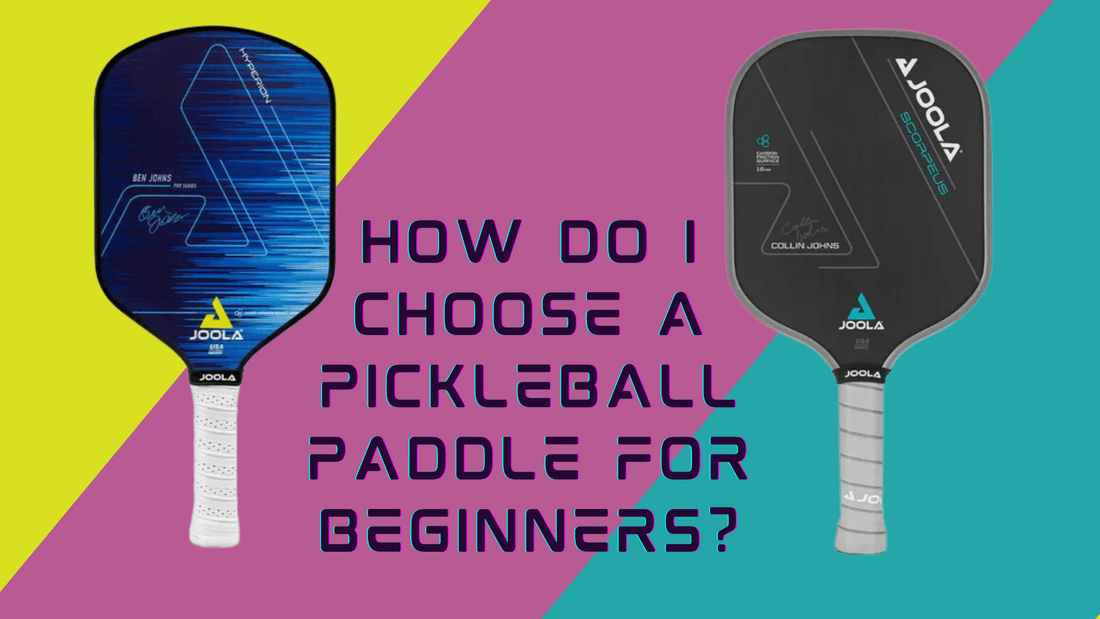
How do I choose a pickleball paddle for beginners?
Share
Choosing the right pickleball paddle can be a bit of a puzzle for beginners. New players in South Africa must consider various factors, like the weight and grip size of the paddle, along with its materials and shape. With pickleball's rising popularity across local communities, it’s key to balance quality and budget while considering how often you'll play and your skill progression potential.
As you navigate options offered by South African retailers, join local groups to share insights on equipment such as assessing core types. Now let’s look into why paddle weight is critical.
Assessing Paddle Weight
The weight of a pickleball paddle is fundamental to a player's game. Heavier paddles, tipping the scales above 8.3 ounces, indeed deliver robust power behind each stroke yet can diminish precision and quickness in play. On the contrary, lighter paddles under 7.3 ounces excel in offering heightened control but might not have that impactful drive needed for authoritative shots.
Seasoned sports enthusiasts appreciate that finding one’s sweet spot is critical for achieving an equilibrium of force and finesse. Pickleball is rapidly gaining popularity among novices and pros alike in South Africa.
Selecting the Right Grip Size

To select the right grip size in pickleball, one must focus on comfort and control. A properly fitted handle can improve play significantly. Players should opt for tennis-style grips; these are designed to enhance performance in games similar to pickleball.
Intermediate players often gravitate towards middleweight paddles ranging from 7.0 to 7.4 ounces due to their balanced blend of power and maneuverability. Lighter models might suit those transitioning from sports like ping pong or racquetball, offering easier wrist action without strain. Important especially when dexterity outweighs brute force during gameplay at Pickleball Zone venues across South Africa.
Remember that beyond weight considerations, how the paddle feels in your hand is paramount: it influences confidence as you swing and serves as an extension of your arm while playing this rapidly growing sport nationally.
Understanding Paddle Materials

Pickleball paddles, integral to the game, come in various materials influencing gameplay. Joola offers many paddles with fibre face offering quality performance and a sizeable sweet spot. Crucial for beginners aiming at precision hits.
Its 8mm honeycomb core ensures power without demanding strength, facilitating learning curve ascension with less effort. Next on the list is Paddletek Phoenix's graphite-layered face which reduces vibrations significantly; this translates into comfort during swift exchanges. A boon for fledgling players seeking both control and enjoyment of rally volleys.
Finally, there’s SLK Latitude characterised by its G4 Control Graphite Face delivering exceptional feel alongside Polymer Rev-Core technology that guarantees consistency across shots. An ideal composition supporting newcomers honing their craft. Each paddle carries USAPA approval guaranteeing tournament readiness while advocating longevity due to enhanced build standards.
One must never overlook these attributes when selecting their quintessential beginner's tool from Pickleball Zone or any renowned outlet providing pickleball equipment in South Africa.
Picking a Proper Shape
In selecting the right shape for a paddle, one must weigh control against power. An elongated silhouette can enhance reach and drive forceful serves and smashes but may sacrifice some facility in quick exchanges at the net. Conversely, wide-body designs foster swift lateral movements and deft volleys with increased surface area to return shots yet might not deliver same punch as their narrower counterparts.
Identifying an individual’s play style is pivotal; those craving more precision could favor wider shapes while players yearning for aggressive gameplay might opt for lengthened models. Ultimately, ergonomic harmony between player preference and paddle architecture – be it broad or slimline – cultivates peak performance on court. Trustworthy advice underpins this guidance ensuring beginners embark confidently equipped onto pickleball arenas with optimally shaped gear from Pickleball Zone's premium selection that champions both form and function without overwhelming novices amidst myriad choices.
Evaluating Core Types
In evaluating the core types of pickleball paddles, one must scrutinize their unique attributes to make an informed choice. Thicker cores increase control. A boon for precision players.
While thinner ones amplify power, essential when force is paramount in your style. Graphite models offer finesse with a lightness conducive to prolonged play and swifter net responses; they're pricier yet less powerful than some alternatives. Carbon fiber strikes a remarkable balance between fortitude and affordability; it's resilient against wear but may lack the oomph sought by advanced competitors.
Wooden variants provide grip aiding spin, but tend toward heftiness compared to modern materials which might hinder swing speed. Aluminum options shine in cost-effectiveness and ease of manipulation without sacrificing stability on contact, making them ideal for beginners or casual enthusiasts. This lightweight option does run a risk of denting with time.
Polymer-based cores are versatile performers known for quiet delivery and sturdy command over shots. They're suited for both gentle touches and robust serves, depending on the thickness chosen for different court scenarios.
Balance Budget with Quality

In pursuing the ideal pickleball paddle, beginners must weigh cost against quality. Wood paddles are economical and robust but may strain your arm due to their heft. A salient point if you foresee lengthy or frequent play sessions.
Onward, composite models present a middle ground; they're crafted for finesse without forsaking sturdiness yet might stretch your budget beyond that of wooden counterparts. Conversely, graphite paddles excel in agility and nuanced control but come with a higher price tag. Investment-worthy for those prioritising deftness over raw power on the court.
Deciding hinges on personal preference aligned with financial reachability and anticipated play time's length and regularity.
Factor in Play Frequency
When choosing a pickleball paddle, consider how often you play. Regular players may prefer paddles with polymer cores for their durable and flexible nature, offering consistent performance over time. Occasional participants might opt for Nomex-core models that provide more immediate power despite potentially quicker wear-out rates.
The frequency of your play will heavily influence the rate at which your equipment endures stress; thus impacting its longevity and overall feel during use. Key aspects to contemplate amidst an array of options available in today's market.
Consider Skill Development Potential
One's journey in pickleball begins with finding a paddle that complements skill enhancement. For novices, the quest for apt equipment is pivotal; one should gravitate towards lighter composite paddles which don't overburden muscles while mastering shots. As prowess flourishes, intermediate enthusiasts may seek graphite variants providing an equilibrium of vigour and finesse crucial for tactical play.
High-calibre contenders often pursue sturdier options like heavier composites or graphites to augment power and precision by net skirmishes. Essential tools sharpening their competitive edge. In addition, grip dimension holds significant sway on performance.
For comfort leads to sustained play without injury risk. And selecting proper edge guards can impact paddle sensation during ball contact. The size plus contour of the instrument must align with individual reach needs as well as sweet spot preferences.
Thusly aligned gear nurtures growth within this sport’s framework whilst increasing pleasure derived from each vibrant rally. The essence of continual progression within pickleball artistry.
Navigating South African Retailers
Venturing into the realm of Pickleball equipment in South Africa requires understanding various currencies and payment options. For enthusiasts looking to purchase their first paddle, it's comforting to know that Pickleball Zone caters widely, accepting diverse forms such as Mastercard, PayPal and Visa. Regardless of whether one resides in urban hubs or far-flung areas like Tristan da Cunha or Tokelau, acquiring a beginner's pickleball paddle becomes hassle-free.
With transparent transactions in New Zealand Dollars (NZD $) across numerous territories including Tanzania and Thailand among others. Pickleball Zone ensures inclusivity for budding players seeking quality entry-level gear without currency constraints.
The Popularity of Pickleball in South Africa
Pickleball's allure in South Africa mirrors the sport's global surge, notably as a more relaxed cousin to padel. Easier to pick up due to its simplified play on smaller courts with slower balls, pickleball appeals across ages and skills – a feature evident in Pickleball Equipment South Africa’s diverse customer base. Unlike the strategic complexity of padel played within walls, pickleball is an amalgamation of badminton and table tennis principles creating accessible enjoyment for new enthusiasts who frequent establishments like Pickleball Zone for equipment suited to their fledgling passion.
Join Local Pickleball Communities
With pickleball, a sport surging in popularity across South Africa, selecting your starting gear is pivotal. For neophytes keen on mastering the basics, large racket faces are recommended; they boost stability and forgive errant swings. Such paddles often feature edge guards for durability.
A boon when scooping low balls to prevent wear from ground strikes. On gripping matters: comfort moulds confidence. Opting for grip sizes matching one's hand negates slippage mishaps mid-game.
Knowing materials matter too. Aspiring players might lean towards composite or fiberglass for their balanced heft without breaking banks like pricier carbon fiber or Kevlar options do yet offering quality above wooden counterparts. Always keep these finer points in mind while navigating Pickleball Equipment South Africa's offerings where choices abound but informed selection reigns supreme.
When selecting a pickleball paddle, beginners should focus on weight and grip size. Lighter paddles increase control while learning strokes but may offer less power. A comfortable grip prevents hand fatigue and improves play consistency.
Beginners might start with an economical option before investing in advanced equipment as their skills develop. Pickleball Zone suggests trying different paddles during practice sessions to find the perfect match for one's playing style and comfort, ensuring a more enjoyable introduction to this rapidly growing sport.
